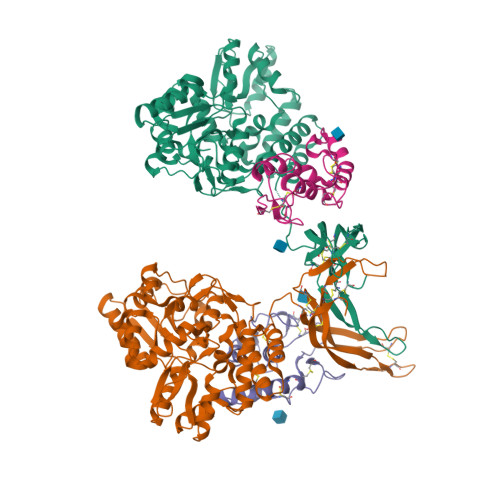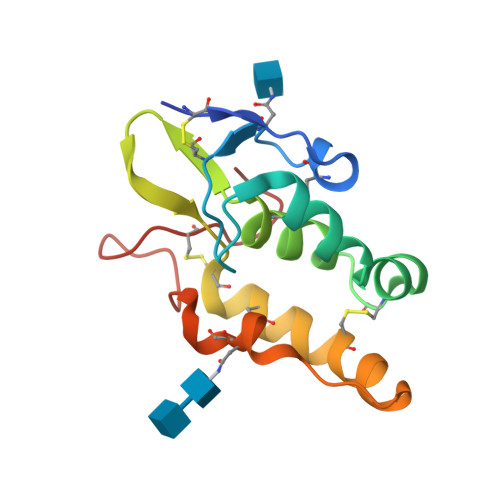1. Acevedo VD, Gangula RD, Freeman KW, Li R, Zhang Y, Wang F, Ayala GE, Peterson LE, Ittmann M, Spencer DM. (2007) Inducible FGFR-1 activation leads to irreversible prostate adenocarcinoma and an epithelial-to-mesenchymal transition.
Cancer Cell, 12 (6): 559-71.
[PMID:18068632]
2. Arthofer E, Hot B, Petersen J, Strakova K, Jäger S, Grundmann M, Kostenis E, Gutkind JS, Schulte G. (2016) WNT Stimulation Dissociates a Frizzled 4 Inactive-State Complex with Gα12/13.
Mol Pharmacol, 90 (4): 447-59.
[PMID:27458145]
3. Canny CL, Oliver GL. (1976) Fluorescein angiographic findings in familial exudative vitreoretinopathy.
Arch Ophthalmol, 94 (7): 1114-20.
[PMID:947162]
4. Chen W, ten Berge D, Brown J, Ahn S, Hu LA, Miller WE, Caron MG, Barak LS, Nusse R, Lefkowitz RJ. (2003) Dishevelled 2 recruits beta-arrestin 2 to mediate Wnt5A-stimulated endocytosis of Frizzled 4.
Science, 301: 1391-1394.
[PMID:12958364]
5. Criswick VG, Schepens CL. (1969) Familial exudative vitreoretinopathy.
Am J Ophthalmol, 68 (4): 578-94.
[PMID:5394449]
6. Dufourcq P, Leroux L, Ezan J, Descamps B, Lamazière JM, Costet P, Basoni C, Moreau C, Deutsch U, Couffinhal T et al.. (2008) Regulation of endothelial cell cytoskeletal reorganization by a secreted frizzled-related protein-1 and frizzled 4- and frizzled 7-dependent pathway: role in neovessel formation.
Am J Pathol, 172 (1): 37-49.
[PMID:18156211]
7. Favre CJ, Mancuso M, Maas K, McLean JW, Baluk P, McDonald DM. (2003) Expression of genes involved in vascular development and angiogenesis in endothelial cells of adult lung.
Am J Physiol Heart Circ Physiol, 285 (5): H1917-38.
[PMID:12842817]
8. Generoso SF, Giustiniano M, La Regina G, Bottone S, Passacantilli S, Di Maro S, Cassese H, Bruno A, Mallardo M, Dentice M et al.. (2015) Pharmacological folding chaperones act as allosteric ligands of Frizzled4.
Nat Chem Biol, 11 (4): 280-6.
[PMID:25751279]
9. Gitter KA, Rothschild H, Waltman DD, Scott B, Azar P. (1978) Dominantly inherited peripheral retinal neovascularization.
Arch Ophthalmol, 96 (9): 1601-5.
[PMID:687201]
10. Gow J, Oliver GL. (1971) Familial exudative vitreoretinopathy. An expanded view.
Arch Ophthalmol, 86 (2): 150-5.
[PMID:5571414]
11. Gregorieff A, Pinto D, Begthel H, Destrée O, Kielman M, Clevers H. (2005) Expression pattern of Wnt signaling components in the adult intestine.
Gastroenterology, 129 (2): 626-38.
[PMID:16083717]
12. Hsieh M, Boerboom D, Shimada M, Lo Y, Parlow AF, Luhmann UF, Berger W, Richards JS. (2005) Mice null for Frizzled4 (Fzd4-/-) are infertile and exhibit impaired corpora lutea formation and function.
Biol Reprod, 73 (6): 1135-46.
[PMID:16093361]
13. Kaykas A, Yang-Snyder J, Héroux M, Shah KV, Bouvier M, Moon RT. (2004) Mutant Frizzled 4 associated with vitreoretinopathy traps wild-type Frizzled in the endoplasmic reticulum by oligomerization.
Nat Cell Biol, 6: 52-58.
[PMID:14688793]
14. Khan NI, Bradstock KF, Bendall LJ. (2007) Activation of Wnt/beta-catenin pathway mediates growth and survival in B-cell progenitor acute lymphoblastic leukaemia.
Br J Haematol, 138 (3): 338-48.
[PMID:17614820]
15. Kirikoshi H, Sagara N, Koike J, Tanaka K, Sekihara H, Hirai M, Katoh M. (1999) Molecular cloning and characterization of human Frizzled-4 on chromosome 11q14-q21.
Biochem Biophys Res Commun, 264 (3): 955-61.
[PMID:10544037]
16. Klein D, Demory A, Peyre F, Kroll J, Augustin HG, Helfrich W, Kzhyshkowska J, Schledzewski K, Arnold B, Goerdt S. (2008) Wnt2 acts as a cell type-specific, autocrine growth factor in rat hepatic sinusoidal endothelial cells cross-stimulating the VEGF pathway.
Hepatology, 47 (3): 1018-31.
[PMID:18302287]
17. Kondo H, Hayashi H, Oshima K, Tahira T, Hayashi K. (2003) Frizzled 4 gene (FZD4) mutations in patients with familial exudative vitreoretinopathy with variable expressivity.
Br J Ophthalmol, 87 (10): 1291-5.
[PMID:14507768]
18. Kondo H, Qin M, Tahira T, Uchio E, Hayashi K. (2007) Severe form of familial exudative vitreoretinopathy caused by homozygous R417Q mutation in frizzled-4 gene.
Ophthalmic Genet, 28 (4): 220-3.
[PMID:18161623]
19. Luhmann UF, Neidhardt J, Kloeckener-Gruissem B, Schäfer NF, Glaus E, Feil S, Berger W. (2008) Vascular changes in the cerebellum of Norrin /Ndph knockout mice correlate with high expression of Norrin and Frizzled-4.
Eur J Neurosci, 27 (10): 2619-28.
[PMID:18547247]
20. MacDonald ML, Goldberg YP, Macfarlane J, Samuels ME, Trese MT, Shastry BS. (2005) Genetic variants of frizzled-4 gene in familial exudative vitreoretinopathy and advanced retinopathy of prematurity.
Clin Genet, 67 (4): 363-6.
[PMID:15733276]
21. Magdesian MH, Carvalho MM, Mendes FA, Saraiva LM, Juliano MA, Juliano L, Garcia-Abreu J, Ferreira ST. (2008) Amyloid-beta binds to the extracellular cysteine-rich domain of Frizzled and inhibits Wnt/beta-catenin signaling.
J Biol Chem, 283 (14): 9359-68.
[PMID:18234671]
22. Masckauchán TN, Shawber CJ, Funahashi Y, Li CM, Kitajewski J. (2005) Wnt/beta-catenin signaling induces proliferation, survival and interleukin-8 in human endothelial cells.
Angiogenesis, 8 (1): 43-51.
[PMID:16132617]
23. Mikels AJ, Nusse R. (2006) Purified Wnt5a protein activates or inhibits beta-catenin-TCF signaling depending on receptor context.
PLoS Biol, 4 (4): e115.
[PMID:16602827]
24. Pan W, Choi SC, Wang H, Qin Y, Volpicelli-Daley L, Swan L, Lucast L, Khoo C, Zhang X, Li L et al.. (2008) Wnt3a-mediated formation of phosphatidylinositol 4,5-bisphosphate regulates LRP6 phosphorylation.
Science, 321 (5894): 1350-3.
[PMID:18772438]
25. Planutis K, Planutiene M, Moyer MP, Nguyen AV, Pérez CA, Holcombe RF. (2007) Regulation of norrin receptor frizzled-4 by Wnt2 in colon-derived cells.
BMC Cell Biol, 8: 12.
[PMID:17386109]
26. Qin M, Hayashi H, Oshima K, Tahira T, Hayashi K, Kondo H. (2005) Complexity of the genotype-phenotype correlation in familial exudative vitreoretinopathy with mutations in the LRP5 and/or FZD4 genes.
Hum Mutat, 26 (2): 104-12.
[PMID:15981244]
27. Ranchod TM, Ho LY, Drenser KA, Capone Jr A, Trese MT. (2011) Clinical presentation of familial exudative vitreoretinopathy.
Ophthalmology, 118 (10): 2070-5.
[PMID:21868098]
28. Rawal N, Castelo-Branco G, Sousa KM, Kele J, Kobayashi K, Okano H, Arenas E. (2006) Dynamic temporal and cell type-specific expression of Wnt signaling components in the developing midbrain.
Exp Cell Res, 312 (9): 1626-36.
[PMID:16510140]
29. Regard JB, Sato IT, Coughlin SR. (2008) Anatomical profiling of G protein-coupled receptor expression.
Cell, 135 (3): 561-71.
[PMID:18984166]
30. Riccio G, Bottone S, La Regina G, Badolati N, Passacantilli S, Rossi GB, Accardo A, Dentice M, Silvestri R, Novellino E et al.. (2018) A Negative Allosteric Modulator of WNT Receptor Frizzled 4 Switches into an Allosteric Agonist.
Biochemistry, 57 (5): 839-851.
[PMID:29293331]
31. Robitaille J, MacDonald ML, Kaykas A, Sheldahl LC, Zeisler J, Dubé MP, Zhang LH, Singaraja RR, Guernsey DL, Zheng B, Siebert LF, Hoskin-Mott A, Trese MT, Pimstone SN, Shastry BS, Moon RT, Hayden MR, Goldberg YP, Samuels ME. (2002) Mutant frizzled-4 disrupts retinal angiogenesis in familial exudative vitreoretinopathy.
Nat Genet, 32: 326-330.
[PMID:12172548]
32. Shastry BS. (2009) Persistent hyperplastic primary vitreous: congenital malformation of the eye.
Clin Experiment Ophthalmol, 37 (9): 884-90.
[PMID:20092598]
33. Shen G, Ke J, Wang Z, Cheng Z, Gu X, Wei Y, Melcher K, Xu HE, Xu W. (2015) Structural basis of the Norrin-Frizzled 4 interaction.
Cell Res, 25 (9): 1078-81.
[PMID:26227961]
34. Slusher MM, Hutton WE. (1979) Familial exudative vitreoretinopathy.
Am J Ophthalmol, 87 (2): 152-6.
[PMID:434067]
35. Stenson PD, Ball EV, Mort M, Phillips AD, Shiel JA, Thomas NS, Abeysinghe S, Krawczak M, Cooper DN. (2003) Human Gene Mutation Database (HGMD): 2003 update.
Hum Mutat, 21 (6): 577-81.
[PMID:12754702]
36. Su AI, Wiltshire T, Batalov S, Lapp H, Ching KA, Block D, Zhang J, Soden R, Hayakawa M, Kreiman G et al.. (2004) A gene atlas of the mouse and human protein-encoding transcriptomes.
Proc Natl Acad Sci USA, 101 (16): 6062-7.
[PMID:15075390]
37. Tickenbrock L, Schwäble J, Wiedehage M, Steffen B, Sargin B, Choudhary C, Brandts C, Berdel WE, Müller-Tidow C, Serve H. (2005) Flt3 tandem duplication mutations cooperate with Wnt signaling in leukemic signal transduction.
Blood, 105 (9): 3699-706.
[PMID:15650056]
38. Wang Y, Huso D, Cahill H, Ryugo D, Nathans J. (2001) Progressive cerebellar, auditory, and esophageal dysfunction caused by targeted disruption of the frizzled-4 gene.
J Neurosci, 21 (13): 4761-71.
[PMID:11425903]
39. Wang Y, Macke JP, Abella BS, Andreasson K, Worley P, Gilbert DJ, Copeland NG, Jenkins NA, Nathans J. (1996) A large family of putative transmembrane receptors homologous to the product of the Drosophila tissue polarity gene frizzled.
J Biol Chem, 271 (8): 4468-76.
[PMID:8626800]
40. Wang Z, Shu W, Lu MM, Morrisey EE. (2005) Wnt7b activates canonical signaling in epithelial and vascular smooth muscle cells through interactions with Fzd1, Fzd10, and LRP5.
Mol Cell Biol, 25 (12): 5022-30.
[PMID:15923619]
41. Xu Q, Wang Y, Dabdoub A, Smallwood PM, Williams J, Woods C, Kelley MW, Jiang L, Tasman W, Zhang K et al.. (2004) Vascular development in the retina and inner ear: control by Norrin and Frizzled-4, a high-affinity ligand-receptor pair.
Cell, 116 (6): 883-95.
[PMID:15035989]
42. Ye X, Wang Y, Cahill H, Yu M, Badea TC, Smallwood PM, Peachey NS, Nathans J. (2009) Norrin, frizzled-4, and Lrp5 signaling in endothelial cells controls a genetic program for retinal vascularization.
Cell, 139 (2): 285-98.
[PMID:19837032]
43. Yoshida S, Arita R, Yoshida A, Tada H, Emori A, Noda Y, Nakao S, Fujisawa K, Ishibashi T. (2004) Novel mutation in FZD4 gene in a Japanese pedigree with familial exudative vitreoretinopathy.
Am J Ophthalmol, 138 (4): 670-1.
[PMID:15488808]
44. You J, Nguyen AV, Albers CG, Lin F, Holcombe RF. (2008) Wnt pathway-related gene expression in inflammatory bowel disease.
Dig Dis Sci, 53 (4): 1013-9.
[PMID:17939044]



















